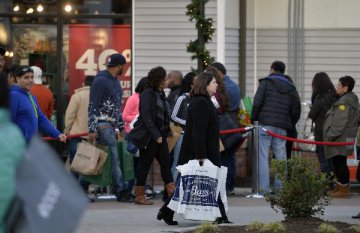Retail sales saw the biggest monthly decline in March since the Commerce Department started keeping records in 1992, falling by a revised 8.3 percent. In April, retail sales dropped by a revised 14.7 percent, setting a new record.
"Due to recent events surrounding COVID-19, many businesses are operating on a limited capacity or have ceased operations completely," the department said in its latest report.
Despite the month-on-month increase, retail sales in May were 6.1 percent below the same month last year, the report noted.
Total sales for the March through May period were down 10.5 percent from the same period a year ago, according to the report.
"May sales came off a very steep fall, so the double-digit gain is welcome, but we cannot get caught up in one number," Diane Swonk, chief economist at Grant Thornton, a major accounting firm, wrote in a blog, noting that sales were 42 billion dollars lower than February, pre-COVID-19 shutdowns.
Retail trade sales were up 16.8 percent from April, but 1.4 percent below last year, the report showed. Non-store retailers were up 30.8 percent from May 2019, while building material and garden equipment and supplies dealers were up 16.4 percent from last year.
Noting that the strongest gains showed up in apparel sales, Swonk said deep price cuts and a sharp contraction in April contributed to those gains. She added that apparel sales fell more than 60 percent from a year ago in May.
Sales at food service and drinking places surged 29 percent, while grocery store sales edged higher in May, but not to the level of "panic-buying" in March, Swonk said.
"The opening of some restaurants and bars looks premature, given the spike in COVID-19 hospitalizations that followed a jump in travel and tourism over the Memorial Day weekend," she said.
Swonk said stimulus checks, along with enhanced unemployment benefits, helped many to weather the shutdowns, but food lines lengthened as only about half of renters were confident they could pay rent in May.
Swonk also noted that "high-end" consumers were much more confident as their stock portfolios rallied, and they also may be feeling "a false sense of security" in their jobs, as the airline and many professional service firms waited until June to cut higher level jobs.
U.S. Federal Reserve Chairman Jerome Powell said on Tuesday that the economy may be entering a phase of bouncing back, with the easing of social distancing measures and resumption of business activities, but employment and output will be "well short" of the pre-pandemic level.
"There are parts of the economy that will struggle to return to their old ways of activity, because they involve getting people together closely in large groups," Powell said in a virtual hearing before the Senate Committee on Banking, Housing and Urban Affairs. "And so it's going to take some time to rebuild confidence."
At its policy meeting last week, the U.S. Federal Reserve kept its benchmark interest rate unchanged at the record-low level of near zero, and projected interest rates to remain at the current level through at least 2022.
The central bank also projected that the U.S. economy will shrink by 6.5 percent in 2020, followed by a 5-percent gain next year.
Powell said the economic projections were made with the general expectation that the economic recovery would begin in the second half of the year and last over the next couple of years.
According to the central bank's economic projection, the unemployment rate could fall to 9.3 percent in the fourth quarter of this year, before reaching 6.5 percent by the end of next year.




















Latest comments